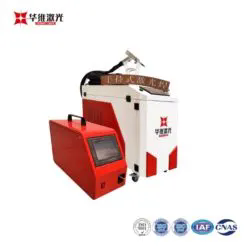Applications of Handheld Laser Welding Machine
2024-07-25
A handheld laser welding machine is a portable and versatile device used for precision welding in various industrial and manufacturing applications. Unlike traditional welding methods, which may require large, stationary equipment, handheld laser welding machines offer mobility and flexibility, making them suitable for welding complex or hard-to-reach areas. Here’s an in-depth look at handheld laser welding machines, including their features, benefits, operation, and considerations:
Features
1. Laser Technology:
- Laser Source: Utilizes a laser beam as the heat source for welding, typically using diode lasers, fiber lasers, or YAG lasers.
- Wavelength: Commonly uses wavelengths such as 1064 nm (fiber laser) which is effective for welding metals.
2. Handheld Operation:
- Portability: Designed to be operated by hand, offering greater maneuverability and access to difficult or intricate weld locations.
- Ergonomics: Features ergonomic handles and controls to reduce operator fatigue during extended use.
3. Power and Performance:
- Adjustable Power: Allows for adjustment of laser power and welding speed to accommodate different materials and thicknesses.
- Cooling System: Includes cooling mechanisms (such as air or water cooling) to maintain optimal operating temperatures and prevent overheating.
4. Control Systems:
- User Interface: Equipped with digital displays and controls for precise adjustment of parameters such as power, speed, and focus.
- Automation: Some models include programmable settings or integration with automated systems for repeatable and consistent results.
5. Safety Features:
- Protective Glasses: Comes with laser safety glasses to protect the operator’s eyes from harmful laser radiation.
- Interlocks and Sensors: Includes safety interlocks and sensors to prevent accidental exposure to the laser and ensure safe operation.
Benefits
1. Precision and Quality:
- High Precision: Provides accurate and clean welds with minimal heat distortion, resulting in high-quality welds with excellent appearance.
- Small Heat-Affected Zone: The focused laser beam minimizes the heat-affected zone, reducing potential damage to surrounding materials.
2. Flexibility and Accessibility:
- Versatile Applications: Ideal for welding various materials including metals (stainless steel, aluminum, copper), plastics, and composites.
- Access to Tight Spaces: Allows welding in confined or complex areas where traditional welding equipment may not reach.
3. Speed and Efficiency:
- Fast Welding: Offers high-speed welding capabilities, increasing productivity and reducing manufacturing time.
- Minimal Post-Weld Processing: Typically requires less post-weld finishing, as the welds are cleaner and more precise.
4. Reduced Heat and Contamination:
- Controlled Heat Input: Provides precise control over the heat input, reducing the risk of thermal damage or warping.
- Clean Process: The laser welding process is generally clean and produces minimal smoke or spatter.
Operation
1. Preparation:
- Material Setup: Prepare and position the materials to be welded, ensuring they are clean and properly aligned.
- Laser Parameters: Set the appropriate laser parameters such as power, speed, and focus based on the material and weld requirements.
2. Welding Process:
- Beam Alignment: Aim the laser beam at the joint or seam to be welded, maintaining proper focus and alignment.
- Welding: Operate the handheld machine, guiding the laser along the weld path to create the desired weld.
3. Post-Weld Inspection:
- Quality Check: Inspect the weld for quality, ensuring it meets the required specifications and standards.
- Cleaning: If necessary, clean the weld area to remove any residues or contaminants.
Considerations
1. Material Compatibility:
- Laser Wavelength: Ensure that the laser wavelength is suitable for the materials being welded. Different materials may require different wavelengths or laser types.
2. Power and Heat Management:
- Power Adjustment: Adjust the laser power based on the material thickness and type to achieve optimal welding results.
- Cooling: Monitor and manage the cooling system to prevent overheating of the machine and maintain consistent performance.
3. Safety:
- Operator Protection: Use appropriate personal protective equipment (PPE), including laser safety glasses, gloves, and protective clothing.
- Work Area: Ensure that the work area is properly shielded and that there are no reflective surfaces that could cause unintended laser exposure.
4. Training and Skill:
- Operator Training: Proper training is essential for operators to effectively use the handheld laser welding machine and achieve high-quality welds.
- Skill Development: Practice and experience will enhance the operator’s ability to control the laser and produce consistent results.
5. Maintenance:
- Regular Checks: Perform regular maintenance and inspections of the machine, including checking the laser optics, cooling system, and electrical connections.
- Cleaning: Keep the machine clean and free from dust and debris to ensure reliable operation.
Applications
1. Manufacturing:
- Precision Parts: Used for welding precision components in industries such as automotive, aerospace, and electronics.
- Custom Fabrication: Ideal for custom or small-batch fabrication where high precision and flexibility are required.
2. Repair and Maintenance:
- On-Site Repairs: Suitable for on-site repair work where traditional welding equipment may be impractical or cumbersome.
- Maintenance Work: Used for maintenance and repair of equipment or structures in various industrial settings.
3. Jewelry and Art:
- Fine Welding: Employed in jewelry making and artistic applications where precision and delicate welding are needed.
Conclusion
Handheld laser welding machines provide a versatile and efficient solution for precision welding across a range of materials and applications. Their portability, precision, and speed make them valuable tools in manufacturing, repair, and custom fabrication. Proper operation, safety precautions, and maintenance are essential to maximizing the benefits of these advanced welding machines and ensuring high-quality results.



